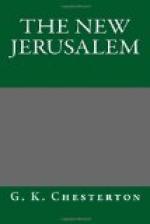of the Renascence. There really is stiff and
ungainly decoration, but it is not the harsh or ascetic
decoration of a Spanish cloister; it is much more
like the pompous yet frivolous decorations of a Parisian
hotel. In short, in so far as the shrine has
really been defaced it has not been defaced by the
Dark Ages, but rather if anything by the Age of Reason.
It is the enlightened eighteenth century, which regarded
itself as the very noonday of natural culture and
common sense, that has really though indirectly laid
its disfiguring finger on the dark but dignified Byzantine
temple. I do not particularly mind it myself;
for in such great matters I do not think taste is
the test. But if taste is to be made the test,
there is matter for momentary reflection in this fact;
for it is another example of the weakness of what
may be called fashion. Voltaire, I believe, erected
a sort of temple to God in his own garden; and we
may be sure that it was in the most exquisite taste
of the time. Nothing would have surprised him
more than to learn that, fifty years after the success
of the French Revolution, almost every freethinker
of any artistic taste would think his temple far less
artistically admirable than the nearest gargoyle on
Notre Dame. Thus it is progress that must be
blamed for most of these things: and we ought
not to turn away in contempt from something antiquated,
but rather recognise with respect and even alarm a
sort of permanent man-trap in the idea of being modern.
So that the moral of this matter is the same as that
of the other; that these things should raise in us,
not merely the question of whether we like them, but
of whether there is anything very infallible or imperishable
about what we like. At least the essentials of
these things endure; and if they seem to have remained
fixed as effigies, at least they have not faded like
fashion-plates.
It has seemed worth while to insert here this note
on the philosophy of sight-seeing, however dilatory
or disproportionate it may seem. For I am particularly
and positively convinced that unless these things
can somehow or other be seen in the right historical
perspective and philosophical proportion, they are
not worth seeing at all. And let me say in conclusion
that I can not only respect the sincerity, but understand
the sentiments, of a man who says they are not worth
seeing at all. Sight-seeing is a far more difficult
and disputable matter than many seem to suppose; and
a man refusing it altogether might be a man of sense
and even a man of imagination. It was the great
Wordsworth who refused to revisit Yarrow; it was only
the small Wordsworth who revisited it after all.
I remember the first great sight in my own entrance
to the Near East, when I looked by accident out of
the train going to Cairo, and saw far away across
the luminous flats a faint triangular shape; the Pyramids.
I could understand a man who had seen it turning his
back and retracing his whole journey to his own country




